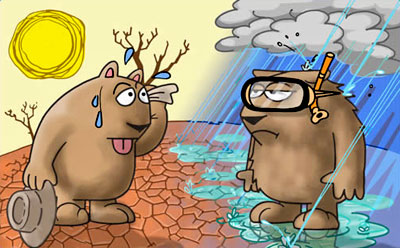|
That’s the sound of some elite power group singing in a choir and each and every time they tout the horn of global warming they fall further into discredit and disgrace.
It’s been extremely hot in New York so
perhaps it’s just the heat getting to the heads of the editorial
department.
The UK has had its
coldest winter in
over thirty years but that information does not put a dent in the
global warming crowd. In England people are glad to leave this past
winter behind, which saw temperatures drop as low as -22 in places.
The winter period December-February was the 18th coldest winter in the contiguous U.S. over the past 115 years, and the coldest since 1984-1985. The February 2010 temperature for the contiguous United States was 32.4 degrees F, which is 2.2 degrees below the long-term average.
But no one is going to argue that it’s not hot in these days in Manhattan but are New York editors so egocentric that just because it’s hot in July they can say we should be doing something about global warming?
Last I checked all information and data have indicated strong cooling of oceans, poles and climate is in effect. Expert senior meteorologist Joe Bastardi is seeing a drastic drop in temperatures in the coming year as something akin to the kind of cooling we saw with the volcano Pinatubo.
He says that even the computer models are looking extreme in the cooling direction with both poles being cold and 75 percent of the Earth with below-normal temperatures. The almighty climate models that have shown global warming in the past are now flashing alarms of a temperature crash, and certain factors like volcanic activity, continued reduction of solar activity, and the ending of the La Niña effect could bring cooling on even more quickly.
As the Earth’s current El Niño
dissipates, the planet will return to the long term temperature
decline brought on
by the Sun’s historic reduction in output, the
on-going “solar hibernation.”
In fact, so far the entire month of July has been cooler than normal.
Russia’s chief meteorological official says this past winter was one for the record books as the coldest ever for Siberia.
He told reporters that while statistics for the coldest eastern part of Siberia have not yet been thoroughly analyzed, western areas received the second-harshest winter in 110 years.
In Far East Russia’s frigid outpost of
Oimyakon, the temperature on January 20 plunged to minus 74 degrees
Fahrenheit, the coldest anywhere in the Northern Hemisphere this
past winter.
A full 70 communities have been declared
disaster zones and Yorkton was the hardest hit with 1,000 flooded
homes. Farmers’ fields are flooded, and grain normally waist high by
now is stunted and struggling. Farmers estimate only 40% of normal
will be harvested this year and that’s with ideal conditions through
the rest of summer.
On July 1st, Governor Chris Gregoire asked U.S. Secretary of Agriculture Tom Vilsack to designate 29 counties in Washington as farm disaster areas due to weather-related losses.
Potato and alfalfa
crops were severely
damaged after a freezing wind swept through east Idaho in the middle
of June.
In England a “perfect storm” of food shortages and water scarcity now threatens to unleash public unrest and conflict, the government’s chief scientist, Professor John Beddington, has warned.
Surging population and food demand, food inflation, diminishing world food stocks, drought, flooding, cold, diminished credit, infestations, soil erosion, industrial farming, factory farm pollution, aquifers/wells going dry, and relocation of produce for energy production are all slamming into a global financial and economic crisis setting the stage for food shortages and price increases that will leave a lot of people starving to death.
Today we have the simultaneous events of
income deflation and food inflation; a financial crisis colliding
with staggering crop losses now colliding with a huge environmental
catastrophe in the Gulf region.
Everyone should be directing consciousness to their medicine cabinets and stocking up on the essentials like sodium bicarbonate (baking soda), magnesium oil, different forms of iodine, activated charcoal, selenium (for a mercury polluted world) and clay for hard detoxification and body cleansing. Also very important are personal food stocks for survival and food security in uncertain times and for this I suggest superfoods like spirulina (for my children), chlorella or Rejuvenate, which is what I personally use.
|


